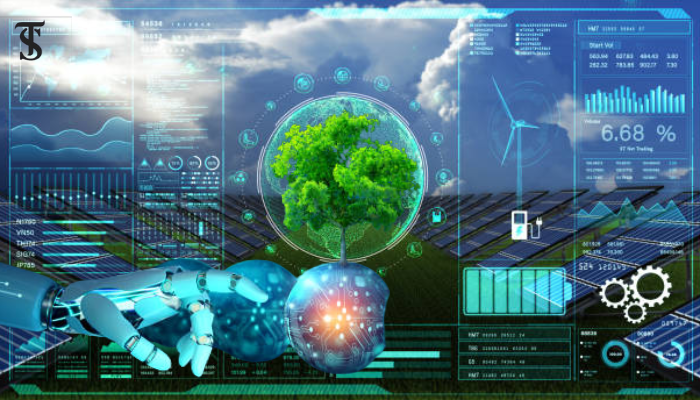AI and Climate Change: A Tech-Driven Solution for a Global Crisis

- AI in Climate Prediction and Early Warning: AI-powered tools like early-warning systems predict extreme weather events, analyze climate-related data, and mitigate conflict risks caused by environmental factors.
- Reducing Carbon Footprints: AI optimizes industrial processes, energy usage, and resource allocation, significantly reducing greenhouse gas emissions and promoting sustainability.
- Challenges and Ethical Concerns: High costs, resource disparities, and potential misuse of AI pose challenges, necessitating global collaboration and a balance between technological advancement and social responsibility.
Artificial intelligence (AI) and climate change are two of the most pressing topics of the 21st century. Both have a significant impact on how societies operate and how the future of our planet might unfold. Surprisingly, the connection between these two fields is becoming stronger as scientists and engineers find innovative ways to use AI to tackle the growing threat of climate change. This fusion of technology and environmental awareness is shaping a new era where smart solutions could play a major role in protecting Earth for generations to come.
To begin with, it is important to understand how serious the issue of climate change is. Rising global temperatures, unpredictable weather patterns, and the alarming frequency of natural disasters have become clear signs that our planet is in trouble. These changes have far-reaching consequences, including food insecurity, mass displacement, and increased sociopolitical instability. AI, with its ability to process vast amounts of data and model complex scenarios, offers innovative solutions to predict and mitigate these challenges effectively.
Consequently, scientists are warning that unless drastic measures are taken, these changes could become irreversible. In such a dire situation, the need for effective solutions cannot be overstated. This is where AI steps in with its ability to analyze vast amounts of data, predict outcomes, and suggest actionable solutions. In such fragile regions, conflicts are further exploited by armed groups and central elites to recruit followers or consolidate power.
Similarly, climate-related disasters force many to migrate, creating additional pressures on resource-strained areas, heightening intercommunal tensions, and leading to social unrest. With environmental shifts intensifying political instability and resource scarcity, researchers and policymakers are leveraging AI-powered tools like Conflict Early Warning Systems (CEWS) to predict and mitigate these risks. These systems analyze vast amounts of historical and real-time data to forecast where and when conflicts might arise, enabling timely interventions that save lives and resources.
CEWS are increasingly incorporating climate-related data, reflecting the growing recognition of how environmental factors drive conflict. For example, systems like the Global Conflict Risk Index (GCRI) produced by the EU use climate variability, freshwater availability, and long-term trends like El Niño to assess conflict risks. Similarly, the Water, Peace, and Security (WPS) partnership focuses specifically on water-related conflict risks, using advanced algorithms to predict how water scarcity could trigger disputes among communities.
One significant application is in early warning systems (EWS) for predicting extreme weather events. These systems leverage machine learning and satellite imagery to forecast hazards such as floods, droughts, and heatwaves, even in areas lacking traditional weather monitoring infrastructure. AI enhances these systems by integrating diverse datasets, such as meteorological conditions, socioeconomic indicators, and local environmental variables, into more accurate and complex models. For example, AI-trained models can predict drought impacts on water availability and agriculture with remarkable precision, offering actionable insights for preventive measures.
According to the Global Commission on Adaptation, giving just 24 hours’ notice of a storm or heatwave can reduce damage by 30%, while a modest $800 million investment in EWS in the Global South could prevent $316 billion in annual losses. This highlights how timely, AI-driven predictions not only save lives but also provide significant economic advantages. For instance, satellite-based sensing systems powered by AI have been particularly effective in regions with limited infrastructure, detecting extreme weather conditions in remote areas and alerting authorities for swift action.
In addition, AI is helping reduce the carbon footprint of industries worldwide. By using machine learning algorithms, companies can optimize their energy consumption, making processes more efficient and less wasteful. For example, AI can analyze the energy needs of a factory and suggest changes in machinery operation or resource allocation to conserve energy. Similarly, AI-powered systems in buildings can automatically adjust lighting, heating, and cooling based on occupancy, reducing energy wastage. Over time, these small but impactful changes contribute to a significant decrease in greenhouse gas emissions.
Transitioning to these innovative approaches is not without challenges. For one, the deployment of AI solutions requires significant investment in technology and infrastructure. Developing nations, which often face the brunt of climate change, may lack the resources to adopt such technologies. Additionally, there are ethical concerns about how AI is implemented. Critics argue that while AI can be a powerful tool, it could also lead to job losses in certain sectors or be misused for purposes that harm the environment rather than protect it. Thus, it is crucial to strike a balance between technological advancement and social responsibility.
Despite these challenges, the potential benefits of using AI to address climate change outweigh the risks. As the world moves forward, collaboration among nations, scientists, and policymakers will be essential to maximize the impact of AI-driven solutions. In many ways, this partnership between human intelligence and artificial intelligence could be the turning point in the fight against climate change. By leveraging the power of AI, we are not only gaining a better understanding of the problems we face but also equipping ourselves with the tools to solve them.
In conclusion, the intersection of AI and climate change offers a glimpse of hope in an otherwise daunting scenario. While climate change continues to pose a serious threat to our planet, AI provides innovative ways to mitigate its effects and create a sustainable future. As technology evolves, so does our capacity to adapt and overcome the challenges ahead. By embracing these advancements and working together, humanity has a chance to protect its home and ensure a brighter future for all.
The author is an expert in peace and conflict studies, currently pursuing her MS in Strategic Studies. Her research focuses on security, human security, and gender, aiming to develop inclusive solutions for national and global challenges.






